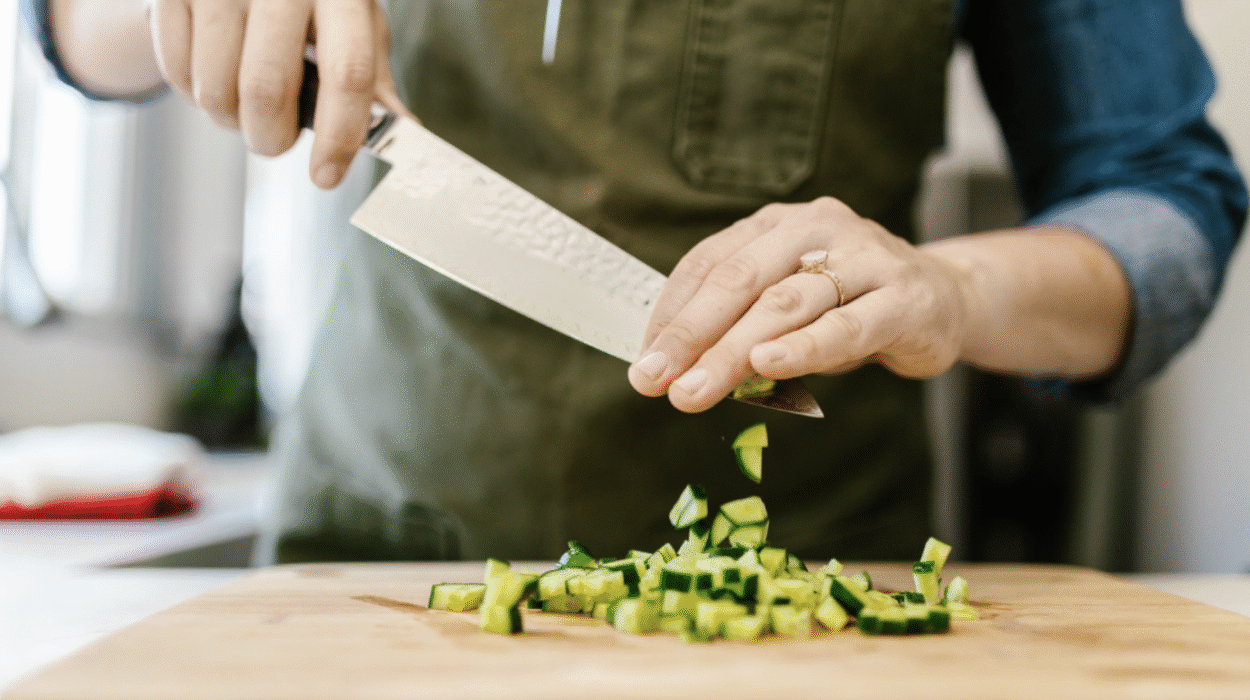When it comes to exquisite craftsmanship and unparalleled performance in the kitchen, German knives have a distinct reputation. Our German kitchen knife review aims to delve deep into what makes these knives a staple in both professional and home kitchens. Whether you’re a seasoned chef or an enthusiastic home cook, this comprehensive exploration will guide you through the nuances of German kitchen knives.

History of German Kitchen Knives
German cutlery has a rich history dating back to the Middle Ages. The tradition of knife-making in Germany is deeply rooted in regions like Solingen, known as the ‘City of Blades’. This heritage is reflected in the meticulous craftsmanship and quality of German knives.
The Solingen Standard
Solingen’s reputation is no accident. The ‘Solingen Standard’ ensures that knives from this region meet high-quality criteria, making them reliable and durable. This tradition of excellence is a significant factor in their global acclaim.
Design and Features of German Knives
German knives are renowned for their robust design and versatility. Typically, they feature a thicker blade, full tang, and a curved edge, making them ideal for rock chopping. These features contribute to their durability and ease of use.
Blade Composition
German knives are traditionally crafted from high-carbon stainless steel, which offers an excellent balance between hardness and rust resistance. This composition ensures longevity and maintains sharpness with regular use.
Performance in the Kitchen
When it comes to performance, German knives are celebrated for their precision and strength. Their weight provides a solid feel, making cutting tasks less strenuous. They are particularly favored for their ability to handle tough jobs like cutting through bones or dense vegetables.
Versatility and Adaptability
The design of German knives allows for a wide range of culinary tasks. Whether you are slicing, dicing, or chopping, these knives deliver consistent results. This adaptability is a key reason why they are a favorite among chefs.
Comparing German and Japanese Knives
While both German and Japanese knives have their merits, they cater to different styles of cooking. German knives are more robust and suited for heavy-duty tasks, whereas Japanese knives are lighter and designed for precision work.
Blade Angle and Sharpness
German knives generally have a blade angle of 20-22 degrees, giving them a sturdier edge. In contrast, Japanese knives typically feature a sharper 15-degree angle, allowing for finer cuts. This distinction is crucial when choosing a knife that fits your cooking style.
Maintenance and Care
Proper maintenance is vital to preserve the quality of German knives. Regular sharpening and cleaning can significantly extend their lifespan. For detailed tips on maintaining your knives, you can explore our guide on German knife care tips.
Sharpening Techniques
Understanding the correct sharpening techniques is crucial. While there are many knife sharpening myths out there, using a whetstone or honing steel regularly can keep your blades in top condition.
Popular German Knife Brands
Several brands stand out in the realm of German knives. Wusthof, Zwilling J.A. Henckels, and Messermeister are renowned for their quality and innovation. Each brand offers a unique take on the traditional German knife design.
Wusthof: A Legacy of Precision
Wusthof is synonymous with precision and quality. Their knives are crafted with attention to detail, ensuring consistent performance. The brand’s commitment to innovation is evident in their cutting-edge designs.
Zwilling J.A. Henckels: Tradition and Innovation
With a history spanning over 280 years, Zwilling J.A. Henckels combines tradition with modern technology. Their knives are a testament to the enduring appeal of German craftsmanship.
Choosing the Right German Knife
Selecting the right knife depends on your cooking style and needs. Consider the size, weight, and blade type that best suits your culinary tasks. A well-chosen knife can significantly enhance your cooking experience.
Handle Comfort and Grip
A comfortable grip is essential for safe and efficient knife use. German knives often feature ergonomic handles, ensuring a secure and comfortable grip during prolonged use.
Price Range and Value
While German knives are an investment, their durability and performance justify the cost. They offer excellent value for money, particularly when maintained properly. For insights into maintaining your investment, refer to our article on knife maintenance mistakes.
Long-term Investment
Considering their longevity and performance, German knives are a worthwhile investment for any kitchen. Their value extends beyond their price, offering reliability and efficiency for years to come.
Conclusion
In conclusion, German kitchen knives are a testament to quality and craftsmanship. Their robust design, versatile performance, and enduring appeal make them a cornerstone in any kitchen. Whether you’re a professional chef or a home cook, investing in a German knife can elevate your culinary skills. For more information on knife care, you can visit Victorinox Knife Care Tips.

FAQs
What makes German knives different from others?
German knives are known for their robust design, high-quality materials, and versatility, making them suitable for a wide range of kitchen tasks.
How do I maintain my German kitchen knife?
Regular cleaning, proper storage, and using the correct sharpening techniques can help maintain the quality of your German knife.
Are German knives worth the investment?
Yes, German knives offer excellent value due to their durability and performance, making them a worthwhile investment for any kitchen.
This article contains affiliate links. We may earn a commission at no extra cost to you.


